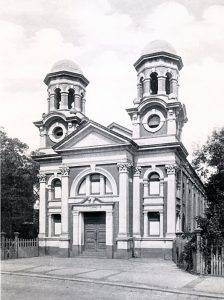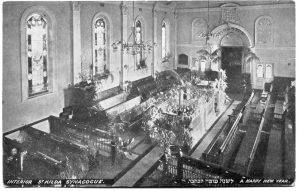The Beginning 1869-1940
Jewish immigrants settled in Victoria from the early days of the Colony, principally from England and Central Europe. By the 1850s they had established synagogues in central Melbourne and East Melbourne, as well as the gold-producing country towns of Bendigo, Ballarat and Geelong.
Since the 1960s Jews lived in the south-eastern suburbs of Melbourne, particularly in the salubrious beachside suburb of St. Kilda. (St Kilda was named by Superintendant Mr La Trobe after a little clipper he saw sailing in front of him – Margaret Wiedenhofer, Garryowen’s Melbourne, 1835-1852 p.64)
On September 3, 1871 a meeting was held at which it was resolved to find suitable premises and attract supporters to establish a Hebrew School and Synagogue in the area. At that meeting, Moritz Michaelis was elected as the first president, Israel Bloomington the Treasurer and H.E. Hart as the Honorary Secretary. In that same year, High Holy Day Services were held in the St. Kilda Town Hall.
Premises were purchased at 17 Charnwood Grove, St. Kilda where the Congregation had its beginnings. This location served until the current Synagogue was consecrated in 1927. With the inauguration of the new Synagogue, 17 Charnwood Grove was refurbished through the generosity of the Harrison family and Harrison Hall served as a communal centre for many years.
Members of St. Kilda Synagogue were prominent in the establishment and support of the Chevra Kadisha (Jewish Burial Society) and the support of the Montefiore Homes for the Aged (established 19 November 1848). As well, the Congregation’s first Chief Minister, Rev. Elias Blaubaum, edited the Australian Jewish Herald. Rev. Jacob Danglow, a graduate of Jews’ College in London, was appointed in 1905, furthering the Congregation’s tie with England. Some members and their children served with great gallantry in the Australian forces during World War I. The Supreme Commander of all Commonwealth Forces, Lieutenant General Sir John Monash, G.C.M.G., K.C.B., V.D.was a member of the Congregation and served on its Board of Management.
Over the years, members were at the forefront of many communal debates, some of which were very controversial. For example, Rabbi Danglow led the opposition against the formation of a Jewish homeland in Palestine. In contrast, some Board Members, including Sir John Monash, supported the Zionist stand. However, in later life Rabbi became a staunch supporter of modern Zionism and the State of Israel.
 In later years, a similar debate ensued regarding the establishment of a Jewish Day School. Senior members of the Congregation found themselves on opposite sides of the debate, their views being forcefully advocated. Those advocating the establishment of a Jewish Day School won the day and the first such school, Mt. Scopus College, was established in 1949. Since then, a number of Jewish Day Schools have been formed and flourish and the Congregation and its leaders, both lay and spiritual, have consistently demonstrated overwhelming support for the Jewish Day School movement.
In later years, a similar debate ensued regarding the establishment of a Jewish Day School. Senior members of the Congregation found themselves on opposite sides of the debate, their views being forcefully advocated. Those advocating the establishment of a Jewish Day School won the day and the first such school, Mt. Scopus College, was established in 1949. Since then, a number of Jewish Day Schools have been formed and flourish and the Congregation and its leaders, both lay and spiritual, have consistently demonstrated overwhelming support for the Jewish Day School movement.
World War 2 and Beyond
Global events have impacted significantly on the Congregation. Members of the Congregation and their sons and daughters participated in all areas of conflict and support during the Second World War. World War 2 and the Holocaust brought refugees to Australia from Eastern Europe in their numbers, many of whom joined the Congregation. More recently, migrants from Israel, South Africa and the former Soviet Union have also joined the Congregation. The centre of Jewish life has gradually moved to the South of the City, which has strengthened the support of our Congregation.
Today, the St. Kilda Hebrew Congregation is seen as a modern Orthodox Congregation. However, some of the well-loved German and English Orthodox traditions are still observed, such as the dignified decorum, choral services and, until recent years, top hat and tails worn by the Wardens (President and Vice-President).
The St. Kilda Hebrew Congregation was and remains the spiritual home to some the oldest Jewish families in Victoria. In the early days in particular, most lived near the Synagogue. Phillip Blashki, who had arrived in Victoria about 1853, made great contributions to the community and the Congregation. His many descendants have continued to participate in community services. The Michaelis and Hallenstein families, as well as many other prominent families, highly respected in the Jewish community and the community at large, still retain a strong association with the St. Kilda Synagogue.
A bequest by the late Mr. Samuel Meyers in 1940 facilitated the building of a hall adjoining the Synagogue, which has served the Congregation as a function hall, classrooms and Succah, and has also been used as a meeting place for the wider community. In November 1984 it was refurbished to incorporate the Adele Southwick Centre and in October 1999 further renovated to provide more accessible facilities. In July 2013, the building again underwent renovations with a total repaint, new carpet, curtains and new heating and air-conditioning. It serves as the venue of the Congregation’s large “overflow service” for those members who cannot be accommodated in the Synagogue on the High Holy Days.
In response to a growing Congregation, the ladies’ gallery was extended in September 1958. In May 1970, the Danglow Centre was opened to house the administration as well as a youth centre. The National Council of Jewish Women used these facilities on a regular basis for social meetings of the elderly, and English classes for Russian migrants were also held there. Today, in addition to the offices, it houses the daily Shacharit morning service and the kitchen is in daily use by caterers.
Members of the St. Kilda Hebrew Congregation have always supported welfare projects amongst their own members and the wider community. Coinciding with the celebrations for the 150th anniversary of the state of Victoria in November 1984, the Adele Southwick Function Centre was opened within the existing Samuel Meyers Hall complex. This facility was used for many years by Refuah, a voluntary society, to prepare kosher meals for hospitals.
In 1995 the Sydney-based Hineni Youth movement selected the Congregation for its Melbourne home and continues to operate with great success in the Danglow Centre. In keeping with modern developments, in 1999 the Synagogue launched its own Internet site on the World Wide Web. In August 2013, a new, updated website was launched at the AGM.

